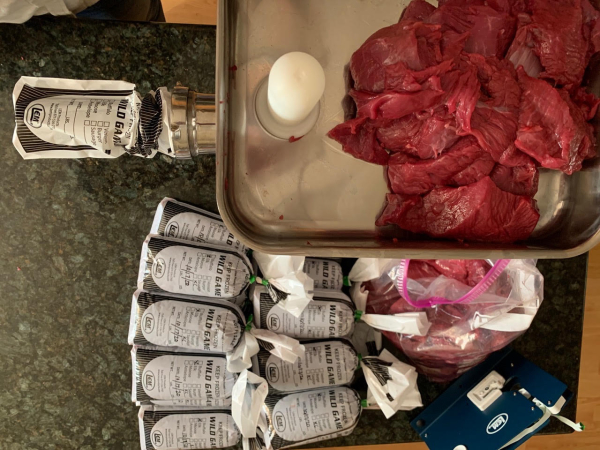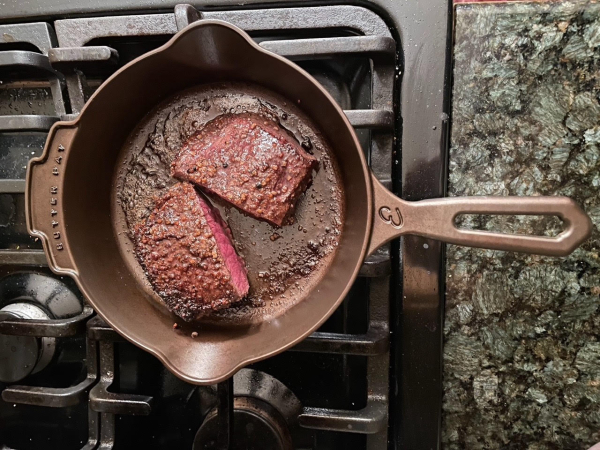Giving thanks for the restoration of wildlife that offers a deeper connection to food
The first meal I ate using meat from the pronghorn buck that I shot myself is by far my most memorable. The sagey scent of the tenderloin immediately brought me back to the place where I was, the place where he had lived his life. With each bite, I could picture that brisk fall morning, seeing my buck for the first time as he grazed up a sagebrush draw in north-central Wyoming. I remembered the mixed emotions as I made the decision to pull the trigger and end his life.

This wasn’t easy for me. I’d supported hunting my whole life through family and friends, and a career choice that brought me into the hunting conservation community. I had hunted as a child before a more than 20-year pause as I pursued that career. In recent years I had started to bird hunt again. But a big game hunt was different, the emotions were bigger.
The connection to where my food comes from was an essential part of why I chose to hunt for myself. Yet, I’m not sure I was fully prepared for how deeply spiritual it would be to take part in the entire process of procuring my own food. This is an opportunity that we have, thanks in large part to having healthy wildlife populations—but it wasn’t always this way.
In the late 1800s and early 1900s, America’s wildlife was thought to be an inexhaustible resource and populations were brought almost to the point of extinction through market hunting and dramatic habitat change. Led primarily by hunting organizations like the Boone and Crockett Club—which was founded in 1887 with the vision of conservation as sustainable use without waste—a series of laws and regulatory changes were put in place to stop unlimited harvest and protect vital wildlife habitat.
However, perhaps the most important factor that put our wildlife resources back on the path to recovery was enactment of the Pittman-Robertson Wildlife Restoration Act in 1937. This law, signed by Franklin D. Roosevelt at the height of the Depression, directed an existing excise tax on firearms and ammunition to state wildlife agencies for the recovery of wildlife populations. This was a critical need because recovery efforts would require significant funding to restore habitat and reintroduce wildlife back to where they once had thrived.
What developed was a partnership between the manufacturers of the products that were taxed, the hunters and shooters that purchased the equipment, and the federal and state agencies that were working to restore the wildlife species that had once been so plentiful. After decades of hard work, all Americans benefited from these efforts. Where deer, elk, turkeys, and numerous other species had been reduced to mere thousands of individuals, we now have thriving populations—thriving to the point that once again, we have a harvestable surplus of animals that allows us to continue to connect with nature and to procure our own food.
Tom Decker, branch manager for communications, analysis, and partnerships with the U.S. Fish and Wildlife Service’s Wildlife and Sport Fish Restoration Program recognizes this important connection. He says that those who participate in hunting are afforded these opportunities from a planned strategy of restoration and management.
“We sometimes forget the scarcity of these species 100 years ago,” he notes. “Restored wildlife populations represent ecological, biological, social, and cultural benefits to the entire public. This planned strategy of restoration and management has allowed for opportunities and access to wildlife species and populations of what are now local wild food—and the number of meals harvested during hunting seasons each year across the continent is remarkable.”
In fact, the Wild Harvest Initiative®, a program of Conservation Visions®, collects and analyzes wildlife harvest data in the United States and Canada. The Initiative estimates that for the five hunting seasons from 2014 to 2019, more than 5.7 billion meals could be served from the almost 2.2 billion pounds of consumable meat from hunted animals. This is a remarkably important source of lean, natural, sustainable protein—and more people are being attracted to hunting for this very reason.


According to research from the Council to Advance Hunting and the Shooting Sports, 73% of hunters are motivated to hunt primarily for the food. As more people become concerned about knowing where their food comes from, a new generation of hunters is interested in heading afield. Joshua Millspaugh, Camp Fire Conservation Professor at State University of New York College of Environmental Science and Forestry and Professor and Director of the Boone and Crockett Club’s University Program at the University of Montana, recognized this potential with students in Montana.
“University students are a unique segment of society—they have an interest in trying new things and are often around a new peer group that might have different life experiences. Many of them take the class because of an interest in sustainable food,” Millspaugh says. “We developed the Wild Sustenance class, with support and collaboration from the Rocky Mountain Elk Foundation, to give students basic information about how to hunt, along with the conservation history to understand the role hunting plays in the restoration of our wildlife species.”
The name Wild Sustenance is intended to connect to the food side of hunting, while also the connection to the outdoors. Through the one semester class, students participate in classroom discussions, but a highlight of the class is the three days they spend on the Boone and Crockett Club’s Theodore Roosevelt Memorial Ranch on the Rocky Mountain Front in Montana. There the students get hands on experience in how to read the landscape, understand wildlife behavior, and safe firearms handling on the Ranch’s rifle range. A key part of the class is the game meat donated by Club members and staff that is used to prepare meals for the students.
“We bring in a wild game chef for the weekend and the students are able to try a wide variety of game meats, as well as help butcher, prepare, and eat a deer that is harvested while they’re on the ranch,” Millspaugh continues. “Students also have the opportunity for a limited access hunt on the Rocky Mountain Elk Foundation’s Bearmouth property a short drive east of Missoula.”

Not everyone who completes the class becomes a hunter, but they leave with a better understanding of wildlife restoration and an appreciation for the role of hunting in society. Millspaugh says that there are some who come into the class who are vegetarian because they are not interested in eating meat from the grocery store. These individuals, however, recognize that hunting provides a more direct link to their food source and if they could harvest an animal and know how it lived and how it was processed, they would be comfortable eating meat.
This presents an aspect to hunting for your own food that is relevant to John McDonald, a past president of The Wildlife Society who is teaching wildlife conservation as chair of the environmental science department at Westfield State University in Massachusetts.
“We have a variety of food choices that our ancestors didn’t have because of our ability to transport food across large distances,” he says. “But all food choices have tradeoffs. Choosing to be a vegetarian affects wildlife because habitat is lost to agriculture. Through hunting, we can have the ability to derive a sustainable food source from wild animals and keep the landscape intact as natural habitat.”
As a former deer and bear biologist with the Massachusetts Division of Fisheries and Wildlife, McDonald has directly seen the success of the Pittman-Robertson Wildlife Restoration Program. “The PR program has a lot of different metrics to assess its effects. Some are obvious like acres protected or species restored or the number of wildlife biologists trained. But another important metric is the recreation and the meals that are derived from these species that were recovered, probably beyond expectations.”


Which brings me back to my own forays into hunting to provide meals for my family’s table. A day in the field for us includes miles of hiking, hours in the most beautiful natural areas, interactions with birds and mammals that I wouldn’t normally see. If I’m lucky—and skilled—enough, those forays will end with protein for my freezer, and meals that bring me right back to those days in the wild with my family. Every year during the holidays this is particularly true as we enjoy summer sausage that we make with our venison as an appetizer, and usually a wild turkey as our main course.
It is our family’s choice for a healthy, sustainable lifestyle—and I do not take for granted the hard work from generations before me, and the wildlife restoration funding, that make such a choice possible. On Thanksgiving, we can all give thanks for this.
— Jodi Stemler
In addition to being an award-winning outdoor writer and communicator, Jodi Stemler heads her own consulting firm specializing in conservation policy and communications projects. Her clients include the Boone and Crockett Club, the Mule Deer Foundation, the Wildlife Management Institute, the Theodore Roosevelt Conservation Partnership, Safari Club International, the Association of Fish and Wildlife Agencies, and many more.
